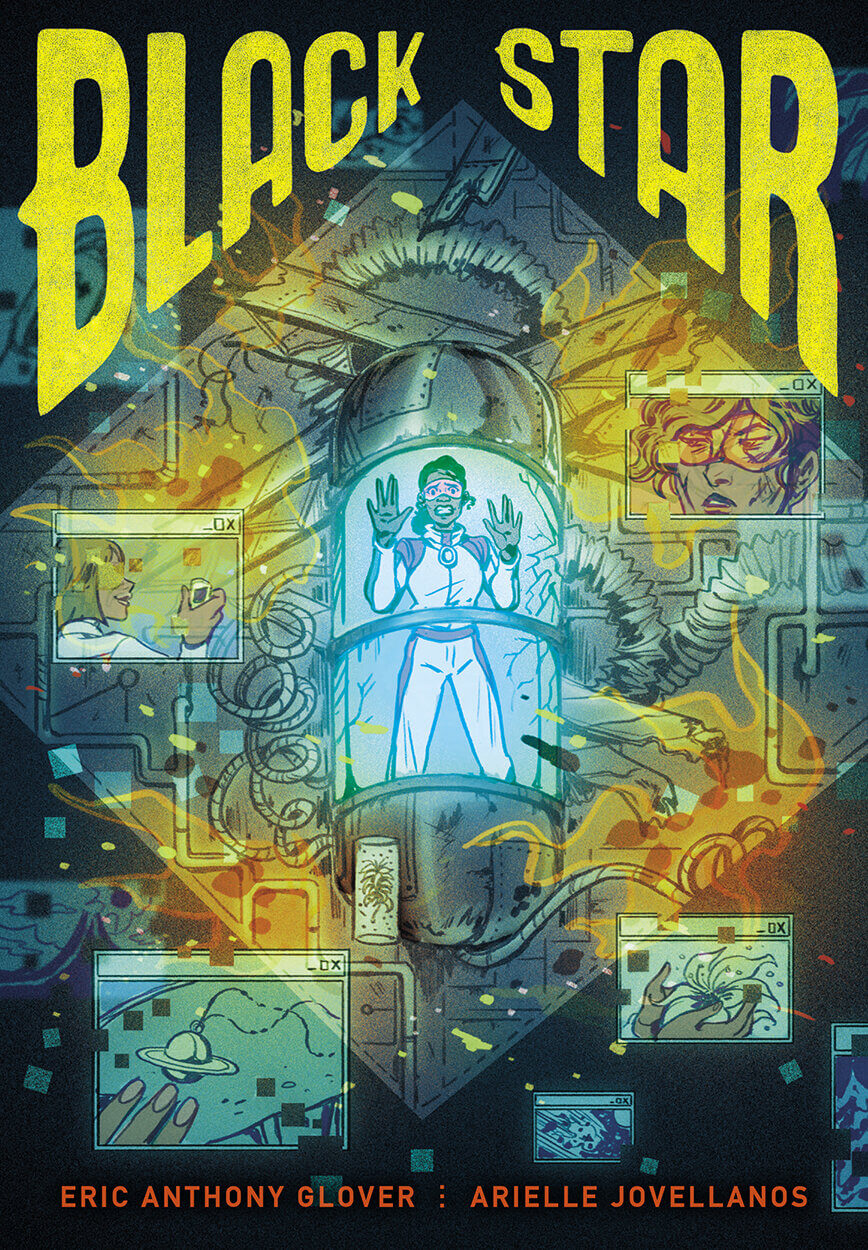Review of Black Star by Eric Anthony Glover, illustrated by Arielle Jovellanos
Extreme temperatures. Flash flood alerts. Wildfires. Sounds like this past summer, no? These conditions are also found on the fictional planet Eleos, the setting for Eric Anthony Glover’s debut graphic novel, Black Star. Brilliantly illustrated by Arielle Jovellanos, the story follows an all-female team of scientists dispatched on a mission into deep space to retrieve a rare flower needed to generate a vital medicine to save human lives.
The mission hardly qualifies as a success. Caught in an asteroid storm shortly after takeoff, the spaceship crashes on Eleos. Most of the crew is killed on impact. Its two survivors—Dr. Harper North, the leader of the mission, and Samantha Parrish, the team’s wilderness expert—are soon pitted against each other in a game of life-or-death. Battered and bruised, they race each other to the ship’s detached escape shuttle: There’s only room for one of them onboard.
The novel opens with North shortly after the crash and much of the action is seen from her perspective, so it makes sense we’d root for her. But through a series of flashbacks, another picture of her character forms that makes us question our allegiance. Turns out, not so many people died on impact as we initially thought. Trapped in the wreckage, Parrish pleads with North to save the ship’s medic, Fletcher, whom we later learn is her lover. North wastes so time leaving them both behind. Freeing herself, Parrish cradles Fletcher’s lifeless body in her arms after failing to resuccitate her. For Parrish, it’s now no longer simply a question of survival. It’s a matter of revenge.
North, making her way across the inhospitable planet to the escape shuttle, is aided by her tablet, the Guardian—sort of like a super-sophisticated, talking Apple watch. It gives her weather updates, acts as a GPS, and provides detailed information on Parrish’s whereabouts. It’s also able to recall conversations, and provide scenes from the past in which North is able to zoom in on details she might have missed while they were happening—for example, Parrish and Fletcher playing footsie under the table. The Guardian is neutral, yet benevolent, vested in the survival of all of the crew members. North, we realize, is subtly manipulating it by the information she feeds it and the questions she asks—an unusual twist on the old man-versus-machine angle.
The longer we spend time with North, the more we wonder, Is this the person we want to survive? Parrish is hostile, unlikable, but clearly wronged—and somehow, therefore, in the right. The action becomes unexpectedly nail-biting as the two get closer to their target—and their inevitable confrontation.
Glover is a screenwriter and he’s conceived this work cinematically; in fact, it’s based on an unproduced screenplay. The scenes are vividly brought to life by Jovellanos’ fantastic illustrations. North is depicted as a beautiful person of color; Parrish, as a scowling, short-haired Caucasian. They often appear in a tight palette of reds (for North) and blues (for Parrish). Their fights, fittingly, are purple-hued. Sort of functioning as a DVD special feature, Jovellanos gives a little background on her process at the novel’s end, discussing some of her inspirations (including Ripley from Alien), her process (using depictions of North’s hair as signals “dramatizing how she goes from a reclusive scientist on a mission to someone just desperately trying to survive”), and how she conceived the action and landscape. Not all of the ideas made it to the finished book, but it’s an interesting look at an artist’s process.
Graphic novels, like film, are a visual medium, but films are aided by what actors bring to their roles. While none of Glovers’ characters fall flat, they sometimes come up a little short for a reader. We’re plunged onto the planet and we’re plunged into the characters’ lives without any idea of what brought them here as people. We’re not given too much to go on about what motivates them (other than the broad strokes of survival and revenge) or what makes them unique. They say and do the things you’d expect characters in a space comic book to do. The real novelty here isn’t the characters, though; it’s Glover’s skillful manipulation of how we feel about them. This is not a place many novelists have found a way to go, and that alone makes Black Star’s trip to space worth the ride.
Author
Discover more from Red Hook Star-Revue
Subscribe to get the latest posts sent to your email.










